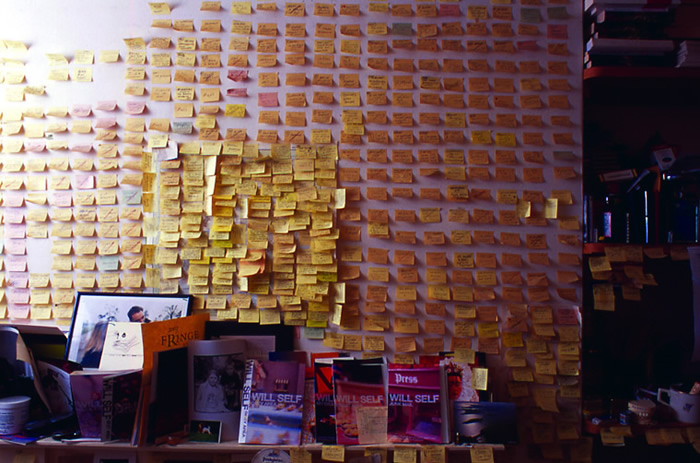Standing on a patch of induced greenery, I stared first at the vast and glassy curvilinear buttocks of Dublin Airport’s newish Terminal Two, then at the shiny cars being shat out from between them along the approach road. I turned and saw the entire sweep of Dublin Bay open out before me: I could see the Wicklow Mountains to the south; the city centre with its hugger-mugger of recent building; the Brobdingnagian bodkin spearing up from O’Connell Street and the triangular roofs of the assemblage of office blocks that Dubliners – with typically irritating self-deprecation – have named “Canary Dwarf”. To the north was the massy brow of Howth Head and before it the long promenade of Dollymount Strand. Out in the bay, the Bull breakwater lanced through the waves. All was in order, all was legible: I had achieved my objective … or had I? I stubbed out my cigarette, turned on my heel and headed for the terminal. In Ulysses, Stephen Dedalus remarks, “History is a nightmare from which I am trying to awake”; and here was I, lapsing yet again into the troubling reverie of international air travel.
I had gone to Dublin with the express intention of understanding a city that to me has always seemed incoherent – and even a little minatory. As I wrote about Manchester a few weeks ago: I never feel I have the measure of a city until I’ve walked across it and felt its heft with my feet. I’ve travelled to Dublin enough over the years, beginning in the early 1980s, when, if my memory serves me, there was as much horse-drawn as motor-propelled traffic on the roads, and the alleyways off the main thoroughfares seemed preternaturally gloomy after dusk. The problem is if you ask Dubliners to take you for a walk around their manor, they invariably concentrate on the Georgian squares, St Stephen’s Green and the immediate purlieu of Trinity College, but pretty as all of this stuff is, it’s no more indicative of the city’s realities than a walking tour of Bloomsbury would be of London’s. To forestall such clichés I arranged for my friend the writer Carlo Gébler to meet me at the airport: we would walk from there out to the Bull and take up our stance where Dedalus, in his earlier Portrait of the Artist As a Young Man incarnation, sees the so-called “heron girl”, and so experiences the earthy epiphany that gives him the impetus to “fly by the nets” of Church, language and nationalism.
There was only one problem with this high-flown promenade: Carlo, not being the most experienced of urban promenaders, had brought a road map rather than a topographic one. Soon enough we were floundering around in a scrubby realm of playing fields, waste ground and cemeteries as we tried to follow the course of a brook across the M1 motorway and towards the coast. We ended up describing a wide and fruitless gyre, before finishing up on the arterial grimness of Swords Road. Neither of us minded – we hadn’t seen one another for nine months and there was plenty to discuss. Besides, this was natal territory for Carlo, whose Bohemian forefathers arrived in Dublin shortly after Dedalus flew the coop, and he was able to point out specific streets that figured in the family history.
All this personalisation helped, but what was more informative still were the feet-that-are-facts on the ground. When Nabokov gave his celebrated lectures at Cornell University in the 1950s he would draw a map on the board to begin with – the “two ways” of Marcel’s Combray, or the floor plan of Mansfield Park – as a prelude to discussing them. I tried the same thing for the students I taught Joyce’s Portrait to last year: sketching out the locations of Clontarf chapel, the wooden bridge, the Bull and the island of dunes that has formed in the past 200 years to its north, so that they can imaginatively place themselves in Stephen’s footsteps. It may not have worked for them but it has for me; in Portrait, Stephen encounters a bevy of beefy seminarians as he crosses the wooden bridge, their muscular-Christian footfalls shaking the entire structure. Carlo and I were pushed to the parapet by tearaways automotively goosing one another. The Bull had become, he told me, a favoured spot for such antics.
We sat out at the end of the breakwater for a while, appreciating the salty zephyrs licking our cheeks. It’s said that another big bodkin, this one topped by a statue of Our Lady of the Sea, was deliberately implanted on the Bull as a faithful rejoinder to the paganism of the epiphany Joyce’s protagonist experiences here – but that seems a little far-fetched to me. True, as we made our way that evening into central Dublin there was plenty of evidence of the festivities to come: on Monday it would be Bloomsday, and folk were gearing up for all the mummery associated with this bewildering bouleversement, whereby one of Hibernia’s most recusant sons has been wilfully co-opted as a national bard.
But really, Joyce himself – in his life and his work – deployed the most effective possible tactic when it comes to comprehending Dublin: he left.
